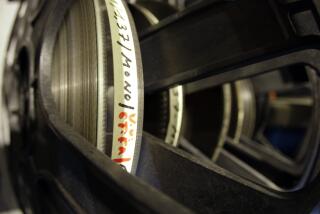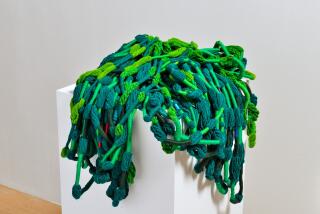Film in the abstract
THE iotaCenter, established to preserve, exhibit and promote the art of abstraction in film and video, will present Kinetica 4, its latest traveling exhibition, at LACMA this weekend.
Curated by William Moritz and produced by iotaCenter director Cindy Keefer, the Friday night offering features “The Sixties: Spirituality and Psychedelia.” Saturday night, it’s “The Contemporary Program of Abstraction,” which will be followed by an added attraction, “A Tribute to Jordan Belson.”
Among the films in the Friday evening program are James Whitney’s “Lapis” (1966) and Jules Engel’s “Rumble” (1975).
“Lapis” is quintessential experimental ‘60s cinema: a constantly changing image of a mandala accompanied by seductive sitar music. The mandala changes colors as it continually reconfigures itself, and to watch this process is to experience a beautiful vision of transcendent spirituality. Whitney and this film are landmarks in this heady era of experimental filmmaking.
Of “Lapis,” Whitney has said it was “as close as I could come at the time of conceiving a totally balanced opposition of stasis and flow, holding the paradox symbolically through wave and particle, pointing to a still center of emptiness.”
“Rumble,” inspired by the gang war in “West Side Story,” is three minutes of black geometric forms against a white background that constantly change in a jolting fashion suggested by its title. Moritz deftly sums up the work of these and other ‘60s experimentalists as “making the soul visible.”
Saturday’s program opens with David Lebrun’s “Tanka,” for which Lebrun filmed a series of Tibetan scroll paintings of mythological subjects and then programmed his footage into an optical printer to create the illusion of animation. The dazzling, vibrantly colored result is a series of dancing gods, wild revels, raging fires and sea battles between monsters.
Ying Tan’s “un Albor” (“Dawn”), a shimmering work of animation, opens with images of sunlight, filtered by fog, reflecting on ocean waves, then takes us inside the cylindrical of a great wave and on to a magical evocation of the cosmos itself, accompanied by the celestial sounds of Jeffrey Stolet. Ying’s point, though elusive, is to suggest a progression from the Earth’s splendid landscape at the dawn of time to the dark night of a human soul.
James Ellis’ “Whisper” is composed of Deco Baroque white scrollery ever shifting its exquisite tracery against a black background.
“A Tribute to Jordan Belson,” composed of four short films compiled by Lebrun, opens with “Allures” (1961), one of the most famous and important works in experimental cinema. It is composed of a series of dazzling displays of shapes and patterns in constant flux ranging from a simple twirling green baton on a blank screen to elaborate bursts of colored rays. Belson’s colors are extraordinarily rich, his use of sound and music contrapuntal in the extreme, and there’s joyous intensity to his work that lifts it above that of many of his contemporaries.
Belson’s work is characterized by an acute tension between precise technology -- he’s a whiz with optical distortions -- and an inspired expression of an unfettered imagination.
“World,” “Chakra” and “Music of the Spheres” -- all from the ‘70s -- flow into each other like a trilogy celebrating the formation of Earth as a turbulent sphere of water in endless permutation, ringed at times by fire and emanating an endless array of explosive pattern and color. It is fitting that Kinetica 4 concludes with the timelessly exhilarating work of Jordan Belson.
*
Screenings
“The Sixties: Spirituality and Psychedelia”: “Lapis” and “Rumble” are among films showing Friday starting at 7:30 p.m.
“The Contemporary Program of Abstraction”: “Tanka,” “un Albor” (“Dawn”) and “Whisper,” Saturday, 7:30 p.m.
“A Tribute to Jordan Belson”: “Allures,” “World,” “Chakra” and “Music of the Spheres,” Saturday, 9:15 p.m.
Where: Los Angeles County Museum of Art, Leo S. Bing Theater, 5905 Wilshire Blvd., L.A.
Info: (323) 857-6010
More to Read
The biggest entertainment stories
Get our big stories about Hollywood, film, television, music, arts, culture and more right in your inbox as soon as they publish.
You may occasionally receive promotional content from the Los Angeles Times.










